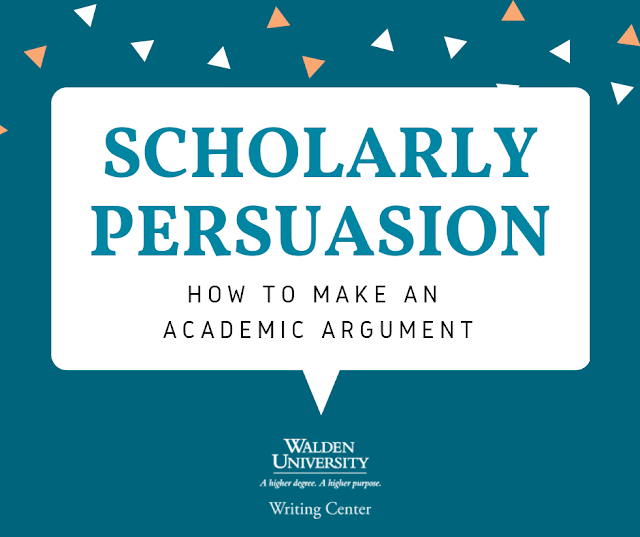Scholarly Persuasion: How To Make an Academic Argument
Monday, September 24, 2018
Expert Advice
,
Featured
,
Scholarly Writing
,
Walden University
10 comments
Whether we think about it consciously or not, our lives revolve around persuasion. Whenever someone watches an advertisement, argues with a friend about the merits of a book or movie, or leaves a contrary comment on a blog post, that person is engaging in the act of persuasion. With that said, formalizing an argument in the classroom can seem difficult, so many writers dread the idea of taking a stance in a persuasive assignment. However, whether the goal is to produce a persuasive paragraph or a 20-page persuasive essay, most persuasive assignments contain similar elements.Before looking at the basic structure of an argument, it’s important to consider that scholarly arguments are not combative or based on opinion. Rather, a scholarly argument is a stance or a position on a topic that can be argued. Scholars create academic arguments based on evidence within research articles or other scholarly sources rather than assumptions and opinions about a topic.
As an example, could I make a scholarly argument that chocolate is very tasty? Probably not, because whether or not chocolate is tasty depends on personal preference and opinion (spoiler alert: Chocolate is tasty). However, could I make an argument that chocolate helps students improve their grades? Now I’m on the right track, as long as I can find scholarly evidence that eating chocolate improves focus or leads to better test grades in a controlled study (wishful thinking, I know). In other words, in order to make an argument, a writer must first choose a debatable topic rooted in evidence and create a position on that topic that others could respond to with counterarguments and evidence.
When writing a persuasive assignment, the first step is to choose a topic that you can argue. If you have a choice of topics, try not to choose on instinct. Instead, try some brainstorming exercises for each possible topic and see which topics lead to the most writing and critical thinking. You might find that one of the topics produces more content during your brainstorming session, even though you originally preferred another topic. Using prewriting techniques such as brainstorming can help you ensure that you meet the assignment length guidelines.
Once you have chosen a topic and a position on the selected topic, you can separate the persuasive assignment into a few different elements:
Context/Background: Your readers should know why this topic is an issue. In other words, why is there a debate about this topic? What makes this topic important to debate? Is there any background information or history that readers need to know about the topic to understand the argument? Providing context for your argument can help readers better understand your position.
Thesis statement/Main idea: The thesis statement is the main argument of your paper. Although the placement of the thesis statement varies, scholars in the United States often place the thesis statement at the end of the introductory paragraph. If the goal is to write a persuasive paragraph, however, the thesis statement might be the very first sentence of the paragraph. Where the thesis statement belongs in your paper depends on the overall length and goals of the assignment.
Evidence: In order to support your thesis statement, you’ll want to include evidence from scholarly sources. Generally, evidence from scholarly publications is more credible than personal anecdotes and experience because other scholars can access this information and draw conclusions about it, whereas they’re unable to access the experiences of other scholars. However, some assignments will call for use of personal experience, so your course instructor is always your best resource if you’re unsure of what kind of evidence to include.
Counterargument: When writing a persuasive essay, writers will generally consider the counterarguments ahead of time, which means that they will consider how other scholars might argue against the thesis statement and respond to those counterarguments in the paper. A counterargument template for my chocolate argument might look like this: Although some may argue that eating too much chocolate contributes to poor health, limiting the amount of chocolate consumed to X amount can help students reap the benefits of chocolate in their schoolwork while avoiding health issues. While adding counterarguments might not be necessary for a persuasive paragraph, considering the counterarguments can help you ensure that you have created a sound argument.
Conclusion: After you finish adding evidence, the next step will be to conclude the argument. For a persuasive assignment, the conclusion generally contains a summary of the argument for readers and the next steps. In other words, what do you want readers to know or do overall? Answering this question can help you wrap up your argument, whether you’re writing a persuasive essay or paragraph.
Now that you know the elements of a scholarly argument, let’s look at an example persuasive paragraph about the aforementioned (delicious!) topic:
Context/Background: Chocolate is generally regarded as junk food rather than health food in the court of public opinion. Thesis statement: However, consuming small amounts of chocolate can help students improve their focus and concentration in their studies. Evidence: According to Doe (2016), students who consumed chocolate before a test scored higher than students who did not consume chocolate. Students who want to improve their coursework might benefit from consuming chocolate before studying or taking exams. Counterargument: Although some may argue that eating too much chocolate contributes to poor health, limiting the amount of chocolate consumed to X amount can help students reap the benefits of chocolate in their schoolwork while avoiding health issues. Conclusion: Overall, consuming chocolate in large quantities is not recommended for a balanced diet, but small amounts of chocolate may help students improve the quality of their schoolwork.Although the amount and type of evidence and the inclusion of counterarguments might vary based on the specific assignment, most persuasive assignments contain the above elements. Once you have added the above elements to a persuasive paper, you have created a scholarly argument!
Using prewriting techniques and considering all angles of your argument can help you persuade your audience to think the way you do about a given topic. In addition, the background information, thesis statement, scholarly evidence, counterargument, and conclusion provide the structure of a strong scholarly argument. I hope that this discussion provides insight into persuasive assignments, but if you want more information and a chance to practice creating scholarly arguments, I recommend watching our Writing Center webinar Building and Organizing Academic Arguments. In the meantime, we’d love to know what you find most difficult about completing persuasive assignments in the comments.
Katherine McKinney is a writing instructor in the Walden University Writing Center. She received an M.A. in English from Valdosta State University in Valdosta, Georgia, and is currently pursuing a Ph.D. in Education at Walden. Katherine's goal as an instructor is to show students that the best writing results from practice, and she aims to provide feedback and resources that will guide students through the invention, composition, and revision process.
.png)
Never miss a new post; Opt-out at any time
Subscribe to:
Post Comments
(
Atom
)





Dear Katherine McKinney,
ReplyDeleteHeartfelt feelings, Gut-instincts, opinions and a little courage to be the first to speak those words many are thinking - the discussion begins !
From there the subject develops into study and research.
Finally, the scholars piece together the results(without bias), the conclusions - the evidence and present the findings.
At this point based on discussions, research and evidence presented, a decision is made. The decision, made through democracy or otherwise, is put into practice.. and civilization moves forward; until the next discussion comes along and we repeat the above procedure.
There are many players in the development of civilization; we are all players.
Please complete the following sentence :
"Not enough Chocolate.."
(Max 3 attempts.)
WaldenU Guest
Jeff
Winnipeg, Canada
Hi, Jeff! We're glad you enjoyed our post!
DeleteThank you !
DeleteYes, I did enjoy Katherine's thoughts on persuasion.
But I have to ask the question- " Is Scholarly writing intended to be persuasive?"
It would be very easy to persuade the audience by simple omission of facts , findings and evidence. But, this seems to cross the borderline of ethics.
Perhaps I am missing the point?
Jeff
Hi Jeff,
DeleteGreat question! Yes, most writing, in some way or another, is meant to be persuasive. In terms of scholarly writing, it is meant to be persuasive without that persuasion being based on personal bias. Rather, scholarly writing intends to be persuasive based on, for instance, research, evidence, and logical argument.
Hi, it was a very interesting write-up.
ReplyDeleteThanks for the excellent job.
Ballard.
Thank you for the positive feedback, Ballard. Good luck developing your scholarly persuasion skills!
DeleteI appreciate the article. The idea of being persuasive is acknowledged as a valid component of communication. Facts must be presented to combat misinformation. The misleading and miseducation is bordering on irresponsible. Propaganda is dangerous and unknowingly or intentionally degrading the integrity of the press. What happens when the public can not discern the truth? Everything becomes shrouded in doubt. Censorship and repercussions for telling the truth places fact driven presenters at risk. While this article helps people understand how to properly relay the facts there is nothing on how to get the facts to an audience. Maybe that could be the subject of another article.--AJC
ReplyDeleteThanks very much for your insight, AJC4. We are truly in a revolutionary time when it comes to finding/disseminating information thanks to the internet. The very nature of "fact" is destabilized because of the infinite amount of voices out there purporting to have the "facts". The challenge is no longer to find facts, but rather to critically engage with information to determine facts for ones self. Keep up the good work!
DeleteKathrine McKinney,
ReplyDeleteI found your synopsis of scholarly persuasion to be very helpful. Thank you for your leadership.
Respectfully,
Jerrell Cogmon
Thanks so much for your kind comment, Jerrell!
Delete